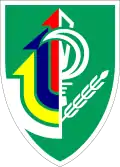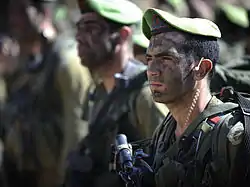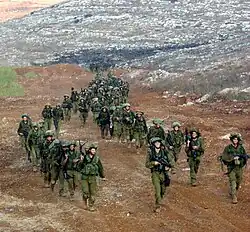Nahal Brigade
The 933rd "Nahal" Brigade is one of the Israel Defense Forces' main infantry brigades. From August 2019 to June 2021, the brigade was led by Yisrael Shomer. On 28 June, Sharon Asman was appointed as the new commander. However, three days later, on 1 July, Asman suddenly died during morning training. As a result, Shomer was issued command again until a permanent replacement could be found.[1]
| 933rd "Nahal" Brigade | |
|---|---|
 Nahal Brigade Insignia | |
| Active | 1982–present |
| Country | |
| Branch | |
| Type | Infantry |
| Role | Infantry |
| Size | 4 battalions |
| Part of | 162nd Division (Israel), Southern Command |
| Nickname(s) | "Sticklights" |
| Motto(s) | "The Human Advantage" |
| Colors | Light green beret ("glow stick green"), Green & White Flag |
| March | "Ha-Nachal Kan" "The Nahal is here" |
| Equipment | Small arms: *X95 Assault Rifle *M40 Grenade Launcher *M72 LAW Vehicles: M113 armored vehicle |
| Engagements | Suez War *Mitla Pass *Six-Day War (reunification of Jerusalem, Umm-Katef) Yom Kippur War First Lebanon War First Intifada Second Intifada Second Lebanon War 2008 Gaza War Operation Protective Edge 2023 Israel–Hamas war |
| Commanders | |
| Current commander | Colonel Yisrael Shomer |
History
It was established as a separate brigade in 1982,[2] in response to the growing need for infantry manpower,[2] before the 1982 Lebanon War. Its 50th battalion was originally part of the Paratrooper Brigade in the 1950s. It is formed mainly from regular draftees, as well as from a core of soldiers from the Nahal group, part of the Nahal movement, which combines social volunteerism, agriculture (historically the establishment of kibbutz farming communities) and military service.[3] Many Mahal foreign volunteers are also known to serve in the Nahal Brigade, providing a highly motivated and disciplined core of soldiers for the brigade.[4][5]
Nahal Brigade soldiers are distinguished by their light green berets,[6] which earned them the nickname "sticklights" (Hebrew for glowsticks). The brigade is composed of 4 active-duty battalions[2] – 50, 931, 932, and 934 (the Gadsar, Hebrew for reconnaissance battalion) – and the various companies on its training base, which together comprise Battalion 933.
It operates on a rotational basis on the most volatile Israeli borders (Lebanon,[7] Syria[8] and Gaza[9]) as well as in the West Bank territories.[10] It is tasked with regular patrol and observation operations on the borders, counter-terrorist operations and riot control in the West Bank as well as tactical assault support to police operations in the territories.[11][12]
It has operated in all major wars and large-scale operations since its inception, playing key roles during the First and Second Lebanon War and the First and Second Intifada.[13]
On 10 June 1982, the Israeli air force mistook a column of IDF Nahal forces for a Syrian commando unit. An IAF F-4 Phantom attacked the Battalion 931, advancing in open APCs in south-eastern Lebanon with cluster ammunition. The unit suffered 24 soldiers killed and 108 wounded, with a further 30 soldiers shell shocked.[14] [15] [16] It was the worst friendly-fire incident in the history of the IDF.
On 4 September 1982, a four-member Palestinian squad attacked an observation post manned by eight soldiers from the Nahal brigade. All the Israeli soldiers surrendered without firing a single bullet. Israel was then forced, in two separate exchange deals, to release almost 6,000 Palestinian prisoners in exchange for the captured Nahal soldiers. The deals were severely criticized in Israel, for being extremely "lopsided". The less than heroic behaviour of the Nahal brigade soldiers was also pointed out. The Nahal Brigade Commander Gilboa went as far as branding the soldiers of his own brigade as "eight cowards".[17]
In November 1987, two PFLP-GC fighters managed to slip through the Lebanese-Israeli border on hang gliders. One of them was cornered and killed by IDF. The second fighter, Miloud Najah from Tunisia, avoided capture and attacked an IDF base outside Kiryat Shemona in northern Israel, manned by Nahal brigade soldiers. In a two minutes exchange of fire Najah succeeded in killing six Nahal soldiers and wounding another ten, before being killed himself. The Palestinian victory was widely celebrated in the Palestinian Occupied Territories and contributed to the outbreak of the First Intifada.
In November 2002 three Nahal soldiers were killed in an ambush in the Palestinian city of Hebron. Another nine IDF soldiers and security personnel were killed in the incident, including Col. Weinberg, the commander of the Hebron brigade, were killed in the clash. The battle was widely seen as a victory for the Palestinian Islamic Jihad, who lost three fighters in the incident.
On 7 October 2023, brigade commander Lt. Col. Yonatan Steinberg was killed during the 2023 Israel–Hamas war.[18]
Training


Nahal Infantry Brigade soldiers undertake around four months of basic training and around four months of advanced training in the Israeli desert.[19]
Basic training: consists primarily of physical conditioning, Krav Maga, rifle training and the qualifying obstacle course.[19] Recruits begin their desert marches at this point in order to prepare them for their beret march at the end of advanced training (70+ kilometers, depending on company). These marches are performed fully kitted in order to prepare them for battlefield marching. Rifle training aims to perfect recruits' day and night shooting skills prior to advanced training. Recruits will also undergo two-man team live firing exercises in the field. Weapon understanding and maintenance is also an important element of basic rifle training. Recruits are taught army values and weapon safety and responsibility.[5] Recruits are also introduced to long field exercises in the desert. There they will learn to survive for the first time on combat rations, limited water, extreme desert heat, sleep deprivation, and field injuries all while being subjected to intense physical activity. Camouflage,[20] fortification construction, combat first aid, and stealth maneuvering will also be taught at this stage.[21]
Advanced training: recruits undergo specialist combat training. This part of the training will primarily take part out in the field.[22] By this stage recruits are expected to comfortably cope with speed-marching in full kit, distances ranging from 15 to 30 kilometers during field exercises. By the end of their training recruits will have been required to march over 400 kilometers through desert and mountainous terrain. Recruits will also be expected to be fully proficient with their rifles, both maintenance and shooting. Recruits displaying certain aptitudes will be sent on various specialist courses: sharpshooter training, squad automatic gunner training,[23] tactical MATADOR-missile training,[24] radio operator's course, advanced camouflage and fortifications course, combat paramedic course,[25][26] APC driver's course, and tunnel and close-quarter training course. Training with helicopters will also be introduced at this stage,[27] although this can vary from draft to draft. All recruits will learn how to conduct live-fire drills at a squad, platoon, and company level. Recruits will learn how to operate both on open field battlefields (desert and mountain) as well as in urban terrain.[28] Room and building clearing training will take place during this stage of training.[13] Recruits will also take part in more advanced Krav Maga training[29] and introduced to crowd-control methods (tear gas, non-lethal ammunition, physical restraint techniques).[30]
At the end of advanced training recruits will qualify as IDF "lochamim" ("warriors") after they complete:
1. War Week: An intense one-week-long war simulation in the field. Recruits will be on combat alert during the whole exercise requiring them to be in full kit, at all times, throughout the week. They will be purposely subjected to extreme sleep deprivation, very limited food rations, and physical exhaustion in order to prepare them for the extreme conditions of war. Recruits will also be required to put into practice their training against heat strokes and hypothermia. Desert temperatures will fluctuate dramatically from day to night. During this time recruits will be expected to cope with intense marches carrying regular kit and support weaponry. Recruits will carry out numerous intense live-firing exercises at a company level, including fire support from the tank and artillery divisions where available. After War Week recruits will earn the Nahal warrior ("lochem") insignia,[31] qualifying them as IDF combat-ready soldiers.[32]
1. Beret March: A 70+ kilometer[33] (depending on company) night march through the desert's mountains. This is performed fully kitted and at full tactical march speed, usually ending at Masada.[33] After this recruits earn their green beret at a ceremony at the Nahal Memorial.
As of 2013 Nahal pioneered a new form of very advanced training[34] aimed at their qualified combat personnel. After advanced training soldiers undergo a further stage of specialist training, combined with border guarding. During this time soldiers will undergo advanced urban warfare training,[35] advanced navigation training, open field and mountain fighting training,[36] Krav Maga, and brigade-wide live fire exercises with support from the artillery, tank, special forces, and air force brigades.[37]
Specific soldiers will be sent on specialist courses including: driver's course, riot dispersal and non-lethal ammunition training, tactical shooting course, and sniper school.[38]
Battalions
- 50th "Bazelet"/"Basalt" Infantry Battalion
- 931st "Shaham"/"Onyx" Infantry Battalion
- 932nd "Granit"/"Granite" Infantry Battalion
- 934th "Topaz"/"Topaz" Reconnaissance Battalion
- "Palsar"/"Flint" Reconnaissance Company
- "Palnat"/"Gazit" Anti-Tank Company
- "Palhan"/"Sapphire" Engineer Company
- "Palhik"/"Agate" Signal Company
Battalions 931 and 932 are composed entirely of soldiers who draft through the Bakum.
The 50th Battalion has a unique makeup. Two-thirds of its companies are made up of bnei gar'inim, groups that spend a year running programs in lower socio-economic communities before being drafted to the army. Following that year, they go through infantry training, taking around 8 months, and then serve in the same manner as other infantry units for about a year. This period is followed by around half a year of community service, at the end of which their term of service closes with another 4–6 months as infantrymen. The other third of the 50th battalion is composed of bakumistim, or soldiers who draft regularly to the unit through the Bakum.
Prior to 2006, it was the case both groups of prospective 50th battalion soldiers were required to pass a two-day gibbush (selection phase) before being drafted in order to get into the 50th Battalion and also that part of the battalion's training comprised a paratrooper course after advanced infantry training (hence Nahal Mutznaḥ, or Airborne Nahal, the name of the battalion before being transferred to the Nahal brigade). Since 2006, however, both the gibbush and the paratrooper course were dropped and the 50th became a regular infantry battalion. In 2010 Nahal soldiers from the 50th Battalion produced IDF Tick Tock, a viral video of themselves dancing as a flash mob in the streets of Hebron.[39]
The fourth active-duty Nahal battalion, the Gadsar (Reconnaissance battalion), was created in the early 1990s to serve as a special reconnaissance detachment for the brigade. Soldiers wishing to serve in this elite battalion must pass a five-day gibbush, a physically and mentally grueling test similar to "hell week" (approximately 1 in 4 finish the week and 1 in 8 are accepted to the training program), after which they are dispersed into specialized training programs for each of the three companies that make up the battalion: the Palsar (Reconnaissance Company), the Palnat (Anti-Tank Company, commonly known as the Orev company), and the Palhan (Engineering and Explosives Company). Soldiers in this battalion undergo an additional 8 months of training in krav maga, urban combat, navigation, camouflage, parachuting and other specialized courses. During periods of low intensity conflict, the companies are tasked with capturing enemies of the state and serve as counter-terrorism forces, raiding terrorist homes and hideouts. Gadsar Nahal won the IDF Chief of Staff prize in 2010 for best land combat unit.[40]
Image gallery
 Camouflage training
Camouflage training Nahal soldiers
Nahal soldiers Returning to Israel after Second Lebanon War
Returning to Israel after Second Lebanon War Nahal Memorial, Pardes Hanna
Nahal Memorial, Pardes Hanna
References
- "Senior Israeli Military Commander Dies After Sudden Collapse During Training." Haaretz, 1 July 2021.
- "IDF - Israel Defense Forces". idf.il. Retrieved 13 June 2014.
- "Nachal Infantry Brigade". Jewish Virtual Library. Retrieved 13 June 2014.
- Raphael Katz. "Mahal Volunteers - Links, IDF and Military Related". mahal-idf-volunteers.org. Retrieved 13 June 2014.
- "Behind the Lines: Serving from the heart". The Jerusalem Post. Retrieved 13 June 2014.
- "From Sunset to Sunrise with the Nahal Brigade". Israel Defense Forces. Retrieved 13 June 2014.
- "Military History Online - Second Lebanon War". militaryhistoryonline.com. Retrieved 13 June 2014.
- "On the border with Syria, the land of war". The Jerusalem Post. Retrieved 13 June 2014.
- "Chefs at the Border: Special Lunch for Soldiers". Israel Defense Forces. Retrieved 13 June 2014.
- "Why training will be the Israeli army's next big battle". TheMarker. haaretz.com. Retrieved 13 June 2014.
- "IDF Soldier Wounded in Grenade Attack - Breaking Israel News". breakingisraelnews.com. 2 May 2014. Retrieved 13 June 2014.
- "Two Terrorists Killed - Others Captured - Latest News Briefs - Arutz Sheva". israelnationalnews.com. 31 October 2004. Retrieved 13 June 2014.
- "Nahal". Israel Defense Forces. Retrieved 13 June 2014.
- http://resilience.har-el.com/Hebrew/Event-DB/66/event.htm אירוע כשל מספר 66: ירי פאנטומים במלחמת לבנון על גדוד 931 בואדי ביאנור
- https://www.ynet.co.il/articles/0,7340,L-4239909,00.html פנטומים יורים עלינו. 30 שנות הלם קרב ynet 9 June 2012,
- Omri Assenheim (13 January 2006). "ידידותי למשתבש". Maariv NRG. Retrieved 20 March 2021.
- Baruch Neah, מפקד הנח"ל על השבויים: "הם היו שמונה פחדנים", ("Nahal Commander on Prisoners: They were Eight Cowards"), Maariv 10 June 1985
- "יוסי יהושוע - Yossi Yehoshua". X (formerly Twitter). Retrieved 7 October 2023.
- "Testing infantry soldiers' combat fitness". The Jerusalem Post. Retrieved 13 June 2014.
- "Camouflage training of the infantry Nahal brigade". 11 February 2008. Retrieved 13 June 2014 – via Flickr.
- "Nahal". garinmahal.com. Archived from the original on 19 July 2012. Retrieved 13 June 2014.
- "Breaking Routine - a set on Flickr". flickr.com. 12 August 2013. Retrieved 13 June 2014.
- "Heroes of the Israel Defense Forces". Behrman House Publishing. Retrieved 13 June 2014.
- "The future infantry soldier: lethal, fast and... victorious". The Jerusalem Post. Retrieved 13 June 2014.
- Zitun, Yoav (27 October 2013). "First responder: Meet IDF medic who treats wounded Syrians - Israel News, Ynetnews". Ynetnews. ynetnews.com. Retrieved 13 June 2014.
- "IDF - Israel Defense Forces : Competition sharpens combat medic's skills". idf.il. Retrieved 13 June 2014.
- "PHOTOS: Elite Soldiers Embark on Helicopter Mission". Israel Defense Forces. Retrieved 13 June 2014.
- "Preparing for the northern arena: Nahal Reconnaissance Battalion". The Jerusalem Post. Retrieved 13 June 2014.
- "No Surprises: Preparing For Israel's Enemies". Israel Defense Forces. Retrieved 13 June 2014.
- "Bridges for Peace » News » IDF Holds Advanced Training on Riots". bridgesforpeace.com. Retrieved 13 June 2014.
- "The Israeli Forces - Nachal Warrior Pin, Insignias, Nachal". israeli-forces.com. Retrieved 13 June 2014.
- "War Week | Beaches and Bullets". beachesandbullets.wordpress.com. 9 July 2011. Retrieved 13 June 2014.
- "IDF Soldier From New Zealand Gets Surprise Visitor at End of 70km March". Israel Defense Forces. Retrieved 13 June 2014.
- "IDF Infantry Train for the Future of War". Israel Defense Forces. Retrieved 13 June 2014.
- Zitun, Yoav (7 February 2013). "Officer: If IDF enters Lebanon, we'll have lasting quiet - Israel News, Ynetnews". Ynetnews. ynetnews.com. Retrieved 13 June 2014.
- "Nahal battalion in surprise Golan Heights war drill". The Jerusalem Post. Retrieved 13 June 2014.
- "IDF - Israel Defense Forces : Nahal Brigade marks 30 years to its establishment". idf.il. Retrieved 13 June 2014.
- "IDF Snipers: Seeing but Unseen". Israel Defense Forces. Retrieved 13 June 2014.
- Soldiers' 'Tik-Tok' video on YouTube, Yaakov Katz, 7 June 2010, Jerusalem Post.
- Archived 24 March 2012 at the Wayback Machine IDF website.
External links
 Media related to Nahal Brigade at Wikimedia Commons
Media related to Nahal Brigade at Wikimedia Commons- IDF website section on Nahal Brigade
- Official Nahal Website (Hebrew)